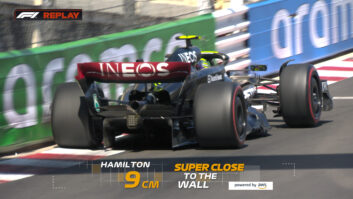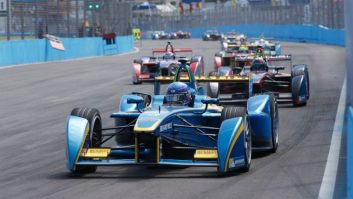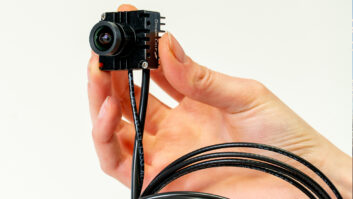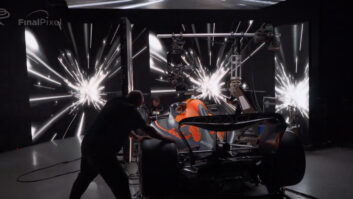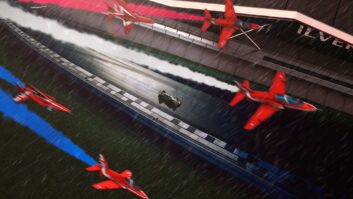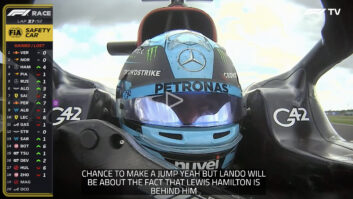As live sports return to TV screens, the industry is making a massive effort to ensure people stay safe and protected from Covid-19. Many new protocols have been introduced that extend right across the board, covering everyone from talent and presenters to behind the scenes crews and technicians. Working in bubbles is the new norm, with crews often isolating for days before the start of a project just to ensure everyone is virus-free.
From the viewers’ point of view, there have also been changes. The lack of fans and crowd noise at sports venues, for example, has taken a bit of getting used to, and some programmes look quite different with pundits sitting far apart in studios or only participating through video links. But for the most part audiences have been very accommodating because everyone understands the constraints imposed by this strange new world.
One change many viewers have noticed is the prevalence of the boom microphone, which are now visible in places where they were never allowed before. In pre-Covid times getting a boom in shot was a major blooper, but these days safety dictates that they are much better suited to certain situations and therefore compromises have to be made.
The sound recordists responsible for delivering this year’s ABB FIA Formula E coverage are among those who have embraced boom mics, particularly for behind the scenes interviews.
Like so many sports, Formula E faced challenges because the Covid-19 pandemic threatened to scupper its 2019/2020 season. Normally Formula E’s fully electric, single seater cars race around major city centres, but because of the high population density in these locations the usual format was deemed unsafe. After months of deliberation a novel solution was found – namely to complete the season by holding six races over nine days, behind closed doors, at Berlin’s iconic Templehoff airport. Live TV coverage was provided by host broadcasters Aurora Media Worldwide and North One TV, known as Formula E TV, who supply the world feed to channels such as the BBC, Eurosport and Mediaset.
Formula E TV’s sound supervisor Paul Halstead heads a dedicated crew of sound engineers, many with extensive live broadcast experience. Paul, who has been involved in Formula E since its first season six years ago, says: “We work as a team but we have very distinct roles. My colleague Scott Morton looks after ENG crews and is involved with the live presentation element, while I handle mic allocation around the track and mixing the international feed, along with any additional race support presentation.”
For the Berlin races, Scott and Paul had to contend with the German government’s social distancing rules, which meant making changes to how the audio was captured. Handheld microphones shared between interviewers and drivers were obviously out, so they switched to boom microphones and used Bubblebee Industries’ Spacer Bubble to get the right balance between wind protection and audio transparency.
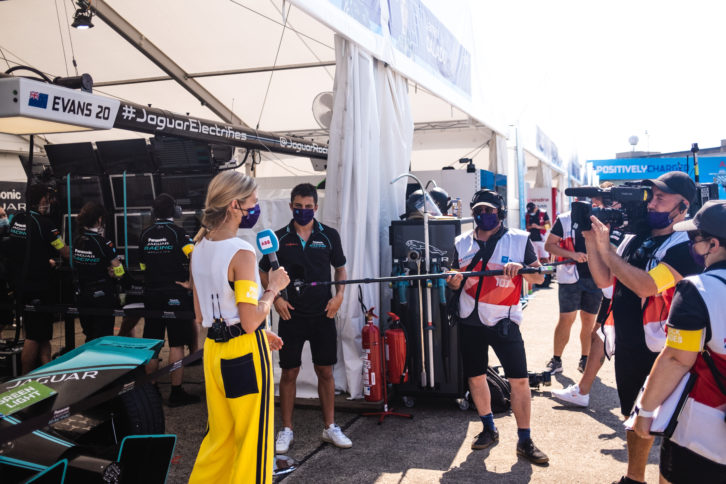
“Switching to boom mics was a major safety protocol and we used them for more than 80 per cent of our ENG and live presentation audio,” Scott Morton explains. “In this new landscape, presenters can’t get close enough to the drivers to share a handheld mic, and our sound engineers are not allowed to touch the talent so we can’t easily fit lavaliers. Our solution was to give presenters their own stick mic and couple them with a sound engineer who would use a boom mic to capture the interviewee’s responses.”
Morton adds that the three piece Spacer Bubble windshield system proved a real winner during the event because it could be adapted to suit the weather and ambient noise levels.
“Unlike other systems that are full on fur or nothing, Spacer Bubble’s modular nature allowed us to get variations in the shielding and adapt more quickly to changing weather conditions,” he says. “We used them with various Røde and Sennheiser shotgun microphones and got excellent results. As so much of the audio for the Berlin event was captured on boom mics, we didn’t worry about them being in shot during interviews because there was very little we could do about it.”
Since its inception, Formula E broadcasters have had various audio challenges to overcome – not least the fact that electric cars don’t sound anything like a Formula 1 sports car, something that viewers initially found disconcerting.
“For the first two seasons, our sound department was under the microscope because we couldn’t make the races sound like Formula 1,” Halstead says. “People often asked why we didn’t add pre-recorded sounds but that wasn’t the solution because you can’t lie to the public. The cars sound how they sound and it is up to us to capture that as realistically as possible. Fans have now got used to it and accept that Formula E simply sounds different.”
Another challenge – at least in a normal season – are the race venues. Because Formula E is held on public roads, the sound crew has to leave it until the 11th hour to position microphones to capture the sound of the cars.
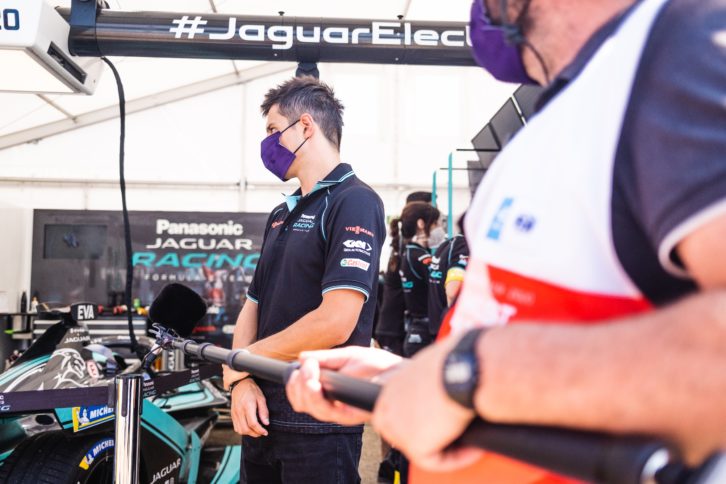
“On a public road you can’t leave anything in place before the race or it may get damaged or stolen,” Halstead explains. “To get round this, I normally get to the track route a couple of days before the race and put tape in places where I want microphones to be positioned, along with connectivity details. Then I finalise the rig plan.”
The track sound assistants use any prep time to label and allocate kit to each camera and run any XLR cable, where possible, in preparation of road closures and then complete the rig when the cameras are rigged ready for the ‘Shakedown’ the afternoon before the race.
A great deal of thought goes into mic placement around the track so that the cars sound exciting.
“It’s a challenge because the biggest criticism of Formula E is the sound of the cars,” says Halstead. “Close miking is one method we use. We get the mics as close as we can to the cars by placing stereo pairs right at the apex of the corners. This allows us to capture the ‘suck’ from the car as it goes past, which adds to the viewer’s enjoyment.”
For the Berlin races, the size of the track – and having three different track configurations – meant running a lot more cable than usual but at least there was time to prepare as no members of the public were present and it’s a closed circuit.
“We connect a stereo pair of microphones to each camera so our mic positions are often dictated by their positions,” Halstead explains. “The cameras have two analogue mic inputs which we use for the stereo pair, but they also have an additional stereo AES input and we can attach additional microphones to that using a custom mic amp CTP System designed by Chris Thorpe. We use these mics for capturing crowds or as run off mics and we work out in advance where we are going to need them.”
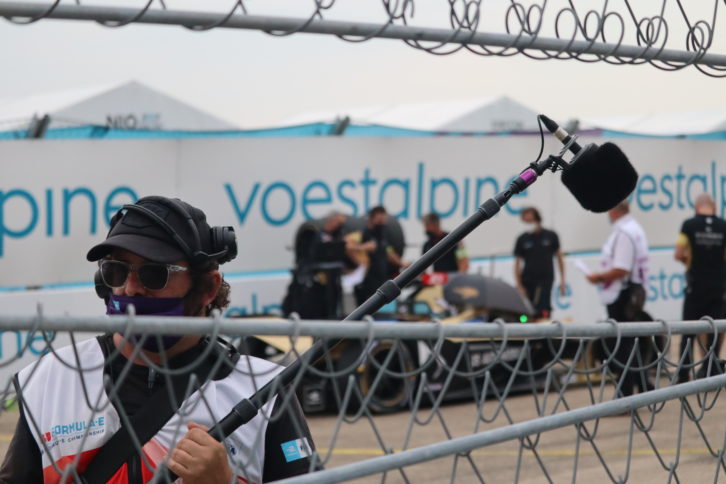
He adds that Formula E has also invested in a Wisycom RF over Fibre system that converts radio waves into light and uses fibre optic cables to transmit audio back to the control room. RFoF is not distance limited like coax cable, making it possible for crews to position camera and sound equipment much further away.
“Bearing in mind we are usually operating in city centres where there are a lot of issues regarding RF coverage, having this Wisycom fibre system has made a big difference. We can now work with multiple microphones, in multiple areas and without having a 160 milli second delay that the RF camera channel introduces when using dual channel camera receivers.
“In the past the ‘presenter microphones’ would come back via the camera receiver and the delay meant you could not give them their own voices in their ears. You also had problems if a camera developed a fault as you had to potentially retune receivers live ‘on air’. We still use ‘camera back’ receivers as backups as you always need some redundancy.”
Capturing the sound of the crowd and the city centre is important for atmosphere, so the sound team have come up with a system that allows the crowd to enjoy commentary through a PA without the PA drowning out the sound of the cars.
“The race organisers want to use a PA to create razzamatazz and a city event,” Halstead explains. They also requested that the track mix is fed out over the PA, which had its own challenges! We came up with a clever system that involved feeding our sports presentation team the sound from specific track microphones so that they could create an automated sub mix. They then liaise with the circuit PA sound engineer to create a Zonal system. This mutes or ducks the PA when we are on air and allows the sound of the cars to be reamplified without creating feedback.”
Covid and the social distancing restrictions it has imposed has led to even more innovation, including the adoption of Bubblebee’s Sidekick In-Ear Monitors, which were used for the first time in Berlin this year. These virtually invisible earpieces became a vital piece of the communication jigsaw because they allowed the sound crew, presenters and talent out on the track to communicate with the sound mixers back in the studio.
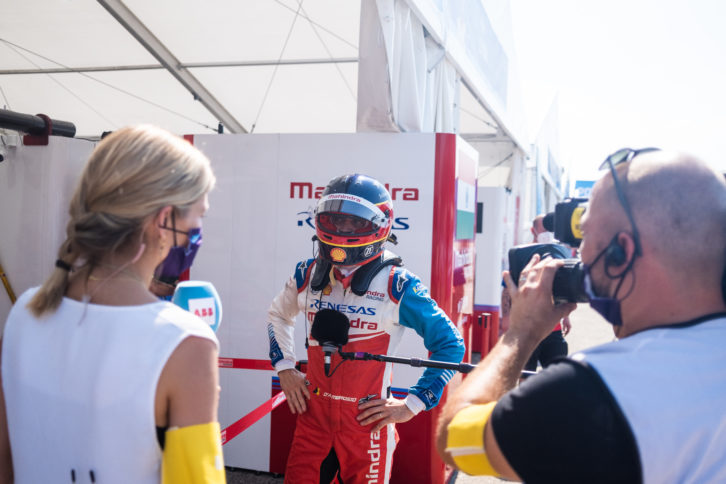
“The earpieces were great at blocking out noise and I was able to communicate very easily with everyone out on the track,” Halstead says. “Formula E is not as noisy as Formula 1, which I have also worked on, but you still require a discrete solution where the presenters can hear the gallery. You can get away with earpieces instead of headphones for comms – and that makes a big difference to how the presenters look on the show.”
Designed to deliver comfort and intelligibility, Bubblebee’s Sidekick In Ear Monitor features the world’s first micro driver solution where the driver itself fits invisibly in the ear canal. Because it is so small and lightweight, it makes a great alternative to earwigs and can be comfortably worn for long periods of time.
Scott Morton adds: “Our main presenters (Nicki Shields and Vernon Kay) were very happy with the Sidekicks and were able to wear them for long stretches of time because they were so comfortable. From an aesthetic point of view it looked better on camera because you couldn’t see the presenters were wearing an earpiece at all. There was one occasion where I gave Nici a telling off for not having her earpiece in when we were about to go on air, only to have to issue a grovelling apology when she pointed out that she did have it in – I just couldn’t see it!”
The presenters fitted and cleaned their own earpieces, which they found very easy. This was especially important because Covid restrictions meant they had to be responsible for their own kit.
“I work on a number of other live shows such as Gogglebox and I shall certainly be recommending Sidekicks to them because they are so invisible,” Morton adds.
Formula E racing will hopefully be returning in 2021 with the first event currently scheduled to take place in Chile in January. Bubblebee windshield and in ear products will be on equipment list as both Scott Morton and Paul Halstead are happy with their performance this year.
